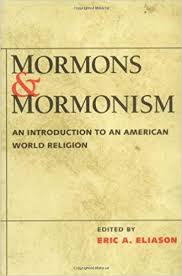Articles/Essays – Volume 35, No. 2
Pluralism, Mormonism, and World Religion | Eric Eliason, ed., Mormons and Mormonism: An Introduction to an American World Religion
This collection of eleven articles from a wide range of fields surveys current and historical Mor monism. It is targeted at an educated audience both inside and outside the traditional readership community in Mormon studies. Several of the essays are landmark studies by major scholars whose arguments go a long way, and church members will find them fascinating, thoughtful reading. Two examples demonstrate why.
The premise of Richard Hughes’s perceptive essay is that early Mor monism partook of a widespread movement in early nineteenth-century America to return to an earlier, more pure church—primitivist, in Hughes’s scholarly description, pre-Apostasy in Mormon terms—the “restoration of all things,” in other words. Unlike other movements, however, early Mor monism was more encompassing in its claims, and, thus, more intolerant of rival claims to salvation. It resulted, in Hughes’s phrasing, in a “coercive vision” and a “violent antipluralism” through which “early Mormons ultimately rejected the ideal of religious pluralism as that ideal has been under stood by most Americans” (39, 41).
In “The Populist Vision of Joseph Smith,” Nathan Hatch argues that the Book of Mormon is a book of “pro found social protest” (126). The under lying premise of the essay is that Joseph Smith is himself the author and that the book speaks of the themes and needs of his own experience of eco nomic struggle and social exclusion. The Book of Mormon appealed greatly to those who were poor outsiders, like Heber C. Kimball, Brigham Young, and others who became members of the first Quorum of the Twelve Apostles. For Hatch, this helps to explain both the church’s appeal and its growth, for a combination of populist entitlement and poverty led these young men to “throw their consider able energy into building a spiritual kingdom in opposition to the competitive and capitalist mores of Jacksonian America” (131).
Not all of the essays lived up to this standard, and on balance, the col lection left several subjects untreated which would need to be addressed in order to serve the intended audience of serious, introductory readers, such as college students in religious studies or American history. If the family is the center of the church today, it is a topic which cries out for more attention in this book. Readers would justifiably expect current demographic information and wonder about the lack of discussion of sexual practices and gender roles in the church (including modern issues like ERA and defense of marriage campaigns, as well as the history of polygamy, about which every out sider already has heard). The church as an institution could also have been ad dressed with great benefit—its administrative development and power, its economic and political influence. (Richard Poll’s interesting essay deals with these issues in passing, but it dates from the 1980s.) The church in the international context would be well served by an essay as thoughtful and well-considered as the historical essays.
The disciplines of history and the ology are represented by strong essays; organizational behavior, anthropology, and sociology leave us wanting more. This is not necessarily bad news—if the book achieves success as a college textbook, a revised edition would have many ways to expand.
One central question remains: has Eliason justified the title which calls Mormonism “an American World Religion”? This returns us to the volume’s theme of where Mormonism has been (its history in New England, in frontier Nauvoo, and then in Utah) and where it is going. It could be argued that the claims of global success are still premature and, thus, perhaps too self-con gratulatory or, more benignly, that they are simply optimistic boosterism. Although such claims may be seductive to scholars of Mormonism who would like to believe their field is expanding and important, other Christian Protestant churches certainly hold at least as much claim to the label of “world religion,” not to mention the Catholic Church, whose global spread truly dwarfs Mormonism’s. And com paring Mormonism to Islam is rather a stretch (at the very least because a millennium of history separates them).
Can a religion (or any institution) be, as the title claims, both American and global? If Mormonism is a world religion, it will have to escape its limitations in American culture. And yet, if we are persuaded by the arguments made in these essays, both a particular American cultural experience (as in Hatch’s essay) and ideological and social boundaries (antipluralism, in Hughes’s essay) have been essential to Mormonism. Are they still so today? Is there room in a universalizing theology for multiculturalism and plural ism? Or do we tend to assume that the American, Mormon experience is (or ought to be) the universal experience? The very existence of such a book as this poses the question of whether there is room in Mormon studies for multiple points of view.
Any Dialogue reader who has not previously read these essays should read them, not only for the essays themselves, but also to consider the question: “What collection of scholarly essays ought to represent the scholarly study of Mormonism to the broader academic community?” The value of this book is to make these views available in one volume, thus allowing the wise reader more easily to place Mor monism in its broader academic, American (and global) context.
Mormons and Mormonism: An Introduction to an American World Religion, edited by Eric Eliason (Urbana: University of Illinois Press, 2001), 250 pp.


 Back to full Issue
Back to full Issue

